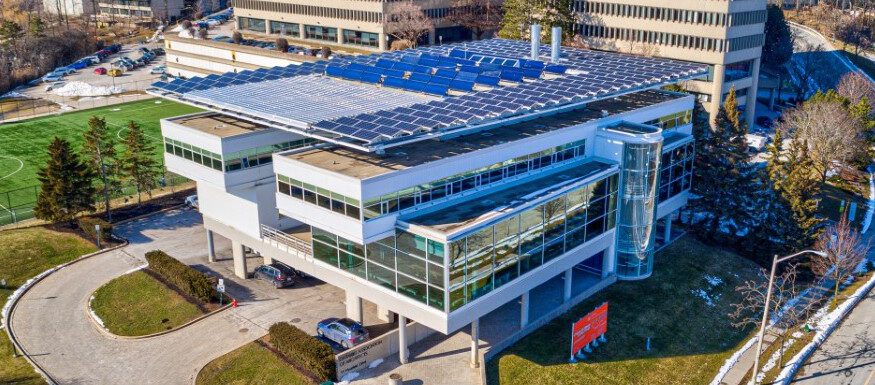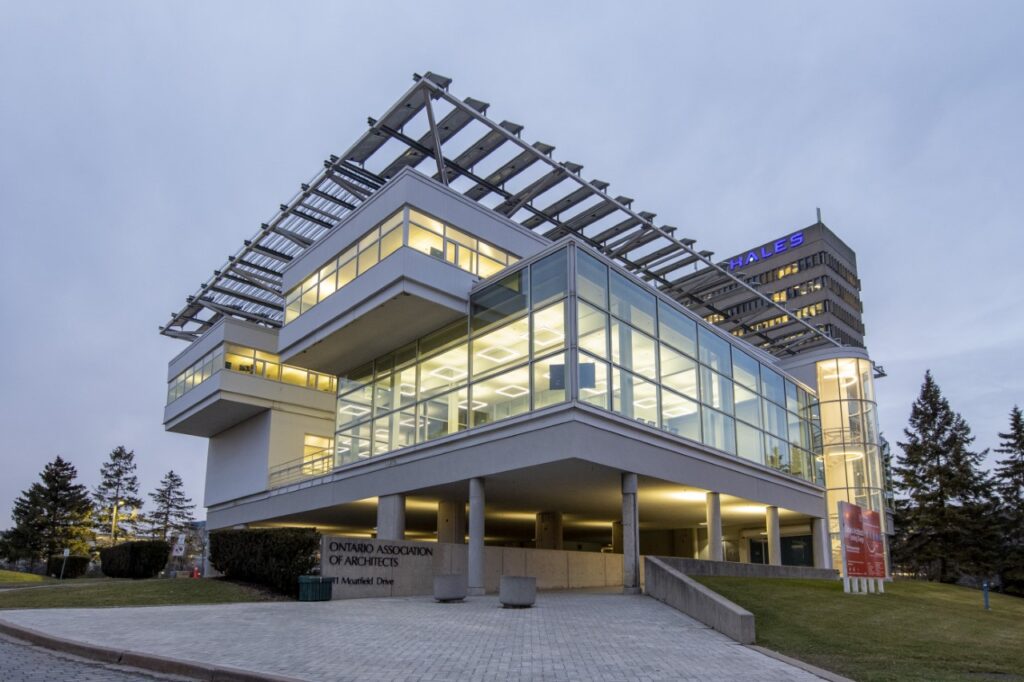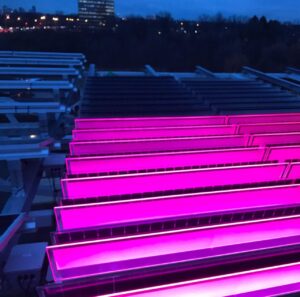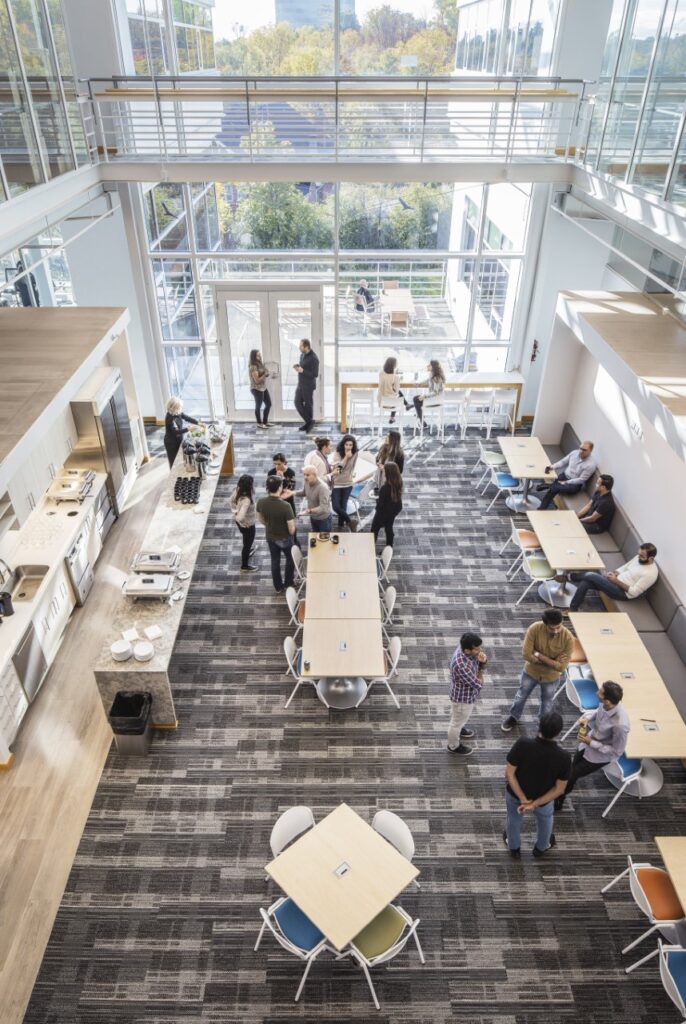Zero Carbon Headquarters Renew + Refresh: Ontario Association of Architects (OAA)

Projects Sponsor
When the Ontario Association of Architects’ headquarters needed repair and reorganization, the OAA asked itself: Could a glass building on stilts with steel beams running through insulated walls become an example of how existing buildings could be adapted to address climate change? Completed in 2019, the headquarters will achieve Zero Net Carbon operations, and double the occupant load while preserving the original design’s spirit.

The windows of the 25-year-old Ontario Association of Architects’ (OAA) headquarters began failing in around 2008, along with the roof and boiler system. It was obvious that something quite radical needed to be done. And because the building is the physical embodiment of architects’ skills and aspirations, it was recognized that what specifically was done, the choices the OAA made around the building, had the potential to matter a great deal.
The OAA’s Sustainable Built Environment Committee (SBEC) had just recommended that the Association pursue the 2030 Challenge as the right framework to guide architects in addressing climate change. Developed by the think tank Architecture 2030, the Challenge’s recommendations go well beyond current sustainability standards and rating systems. It calls for every new building and intensive renovation built after 2030 to be Net Zero Carbon on an operating basis, and not use natural gas.
The OAA considered selling the building and starting fresh, but decided this would send the wrong message: We’re not going to solve the current climate change emergency by simply discarding existing buildings. Rather than waste resources, new ways to improve the performance of our current built environment must be not just developed but widely utilized.
Further, the OAA building’s design was the result of an international competition, held in 1988 and won by local architect Ruth Cawker. The headquarters has roots, a story and maybe a message to send.
The OAA asked itself: Could a glass building on stilts with steel beams running through insulated walls become an example of how existing buildings could be adapted to address climate change? The OAA wanted to show how buildings with historic significance could meet contemporary needs.
From these considerations the project’s core objectives emerged. The OAA wanted the repairs to meet the 2030 Challenge requirement of zero carbon emissions and improve interior comfort and health levels, while simultaneously adjusting the functionality of the building to meet current needs. They wanted to maintain the integrity of the original 1988 design and providing educational opportunities for the membership and the public was a crucial aspect of the project that needed to be built into every stage.
The primary framework for the project came from the 2030 Challenge, which proposed energy intensity as the measure as opposed to the traditional “Reference building/Proposed building” model used by the LEED rating system and the building code. Energy intensity allows for the comparison of new buildings with existing ones, and for a measurement that does not allow poor-performing features, like a curtain wall, to be hidden in the calculations.
A project of this scale is necessarily multi-faceted; a daylighting study was commissioned from Gottesman Associates. Along with ventilation air, electrical lighting is the most significant energy load in office buildings, often ahead of the building envelope. Before the renovation, each side of the building, on each floor, was controlled by a single switch. Typically, the lighting was turned on in the morning and off in the evening.
The daylighting study showed the building could meet lighting standards through much of the day with no artificial lighting at all. Significant reductions in lighting power density were possible, in large part by only turning on the lights when and where they were needed and the report provided design guidance for repair.
Throughout 2015, the firm Interior Architects convened a series of interviews and workshops to determine the needs of the organization, including plans for future growth. They found that the capacity of the building could be doubled, for both office and for member service spaces, Aside from the obvious benefits to the organization, by the measure of energy required per person for comfort, the reorganization of the building doubled the energy efficiency.

In 2017, the OAA entered into an agreement with Sustainable Development Technology Canada to participate in a research project initiated by Morgan Solar, an innovative Canadian company that has developed a new type of solar panel. Approximately 25 percent of the panels on the OAA building are by (past Clean50 Honourees) Morgan Solar, and 75 percent are conventional panels. This will allow a direct comparison between the two systems. OAA council agreed to source furniture from local sources, and to refurbish and reuse existing furniture as appropriate. Construction documents were completed and the project tendered in August.
Begun in January 2018 and completed in 2019, the renovated OAS headquarters will achieve Zero Net Carbon operations, and double the occupant load while preserving the original design’s spirit.

Preliminary results from utility bills alone are that a reduction in costs of 74 per cent has been achieved, despite the higher cost of electricity. This is before lighting is commissioned and all solar panels are operational. All systems are expected to be operational and in spec by September, and the OAA should realize its goal of 46.9 ekWhr/m2 before the solar generation credit is applied.
Among the obstacles encountered during this whole process, is the common assumption that the building industry does not have the technology needed to meet net zero carbon on an operating basis. This is not true. We have the technology. It’s just not cheaper than burning gas, but we know how to build all-electric buildings. What’s required is a different way of thinking about energy.

By literally living in a glass house, and renovating that glass house in a considered, conscientious, global community-minded way the OAA offered a window onto new windows and into installing a direct outside air ventilation system with an energy recovery air handler. They offered a window into opting for a hydronic building perimeter fan coil heating/cooling system, and a geothermal and heat pump system to provide low-temperature heat and free cooling as well as a window into installing solar thermal panels to supplement the geothermal heat and to heat domestic hot water.
In short, the OAA gave us a window into the possibilities and process of Net Zero and beyond.













